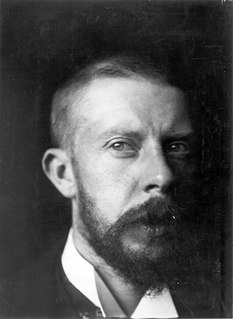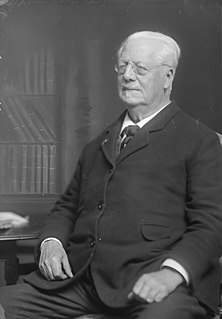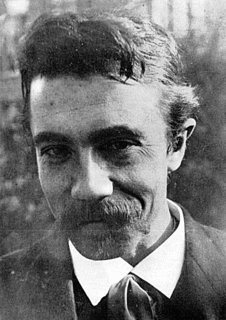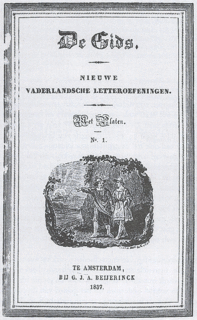
George Hendrik Breitner was a Dutch painter and photographer. An important figure in Amsterdam Impressionism, he is noted especially for his paintings of street scenes and harbours in a realistic style. He painted en plein air, and became interested in photography as a means of documenting street life and atmospheric effects – rainy weather in particular – as reference materials for his paintings.
Dutch language literature comprises all writings of literary merit written through the ages in the Dutch language, a language which currently has around 23 million native speakers. Dutch-language literature is the product of the Netherlands, Belgium, Suriname, the Netherlands Antilles and of formerly Dutch-speaking regions, such as French Flanders, South Africa, and Indonesia. The Dutch East Indies, as Indonesia was called under Dutch colonization, spawned a separate subsection in Dutch-language literature. Conversely, Dutch-language literature sometimes was and is produced by people originally from abroad who came to live in Dutch-speaking regions, such as Anne Frank and Kader Abdolah. In its earliest stages, Dutch-language literature is defined as those pieces of literary merit written in one of the Dutch dialects of the Low Countries. Before the 17th century, there was no unified standard language; the dialects that are considered Dutch evolved from Old Frankish. A separate Afrikaans literature started to emerge during the 19th century, and it shares the same literary roots as contemporary Dutch, as Afrikaans evolved from 17th-century Dutch. The term Dutch literature may either indicate in a narrow sense literature from the Netherlands, or alternatively Dutch-language literature.

Willem Johannes Theodorus Kloos was a nineteenth-century Dutch poet and literary critic. He was one of the prominent figures of the Movement of Eighty and became editor in chief of De Nieuwe Gids after the editorial fracture in 1893. He was nominated for the Nobel Prize in Literature five times.

The Tachtigers ("Eightiers"), otherwise known as the Movement of Eighty, were a radical and influential group of Dutch writers who developed a new approach in 19th-century Dutch literature. They interacted and worked together in Amsterdam from the 1880s. Many of them are still widely read today.

Frederik Willem van Eeden was a late 19th-century and early 20th-century Dutch writer and psychiatrist. He was a leading member of the Tachtigers and the Significs Group, and had top billing among the editors of De Nieuwe Gids during its celebrated first few years of publication, starting in 1885.
This article deals with literature written in Dutch during the 19th century in the Dutch-speaking regions.

Albert Verwey was a Dutch poet belonging to the "Movement of Eighty". As a translator, staffer, and literary historian he played an important role in the literary life of The Netherlands in the late 19th and early 20th centuries.

Jan Pieter Veth was a Dutch painter, poet, art critic and university lecturer. He is especially noted as a portrait painter. Amongst his sitters were Max Liebermann, Lambertus Zijl, Frank van der Goes, Antoon Derkinderen and other contemporaries including various fellow painters.

Willem Witsen was a Dutch painter and photographer associated with the Amsterdam Impressionism movement.

Charles Boissevain was a journalist, editor and part-owner of the Amsterdam Algemeen Handelsblad, a leading newspaper of the time. From 1872 he was on the editorial board of the literary journal De Gids.
Justine Constance Wirix-van Mansvelt was a Dutch Protestant expert on the oeuvre of the Italian poet and writer Dante Alighieri (1265–1321).

Marcellus Emants was a Dutch novelist whose work is considered one of the few examples of Dutch Naturalism. His writing is seen as a first step towards the renewing force of the Tachtigers towards modern Dutch literature, a movement which started around the 1880s. His most well-known work is A Posthumous Confession, published in 1894, translated by J. M. Coetzee.

Henriette Goverdine Anna "Jet" Roland Holst-van der Schalk was a Dutch poet and communist. She was nominated for the Nobel Prize in Literature.

Orchids, a collection of prose and poetry is a collection of prose and poetry written by Dutch writer Louis Couperus, which was published in 1886. Couperus published his debut, A ribbon of poems in 1886 with publisher J.L. Beijers. The rights to publish Couperus' books were taken over by publisher A. Rössing, who then published the second book of Couperus, Orchids, a collection of prose and poetry. After Rössing filed for bankruptcy in 1890 the rights were taken over by L.J. Veen, who would publish the second edition in 1895. In 1989 Veen would reprint Orchids, when Couperus' complete works were published.

Stéphanie Hélène Swarth was a prolific Dutch poet active from 1879 to 1938. She is considered one of the Tachtigers and acquired a reputation as a sonneteer.
LGBT writers in the Dutch-language area are writers from de Lage Landen, that is Flanders and the Netherlands,

Johann Eduard Karsen was a Dutch Post-impressionist painter, known for his moody scenes featuring villages and farmhouses; usually containing a solitary figure. He was associated with the literary movement known as the "Tachtigers".

De Gids is the oldest Dutch literary periodical still published today. It was founded in 1837 by Everhardus Johannes Potgieter and Christianus Robidé van der Aa. Long regarded as the most prestigious literary periodical in the Netherlands, it was considered outdated by the Tachtigers of the 1880s, who founded De Nieuwe Gids in opposition to the periodical. In 2011, De Gids ceased operations, but has been taken over as De-Gids-nieuwe-stijl by De Groene Amsterdammer.

Augusta Guerdina Peaux was a Dutch poet. She began her publishing career as a writer of prose fiction, in literary magazines and in one collection, and in the early 1900s started publishing poetry, in magazines associated with the literary movement known as the Tachtigers, with whom she became associated. With her sister Johanna, she translated poetry by Dante Gabriel Rossetti and Algernon Charles Swinburne, and with her friend Truus, with whom she shared a love for Iceland and its literature, she translated stories from the Edda. Two volumes of her poetry were published; she never sought literary fame, though some fame came to her posthumously.

Jacques Fabrice Herman Perk was an important Dutch poet of the late 19th century, who died young. His crown of sonnets Mathilde, published by Willem Kloos, was the first important announcement of a renewal in Dutch poetry brought about by artists that came to be known as the Tachtigers. Perk's lyrical poems about nature, especially his sonnets, were influenced by Percy Bysshe Shelley, and were of great importance to Dutch poetry.
















